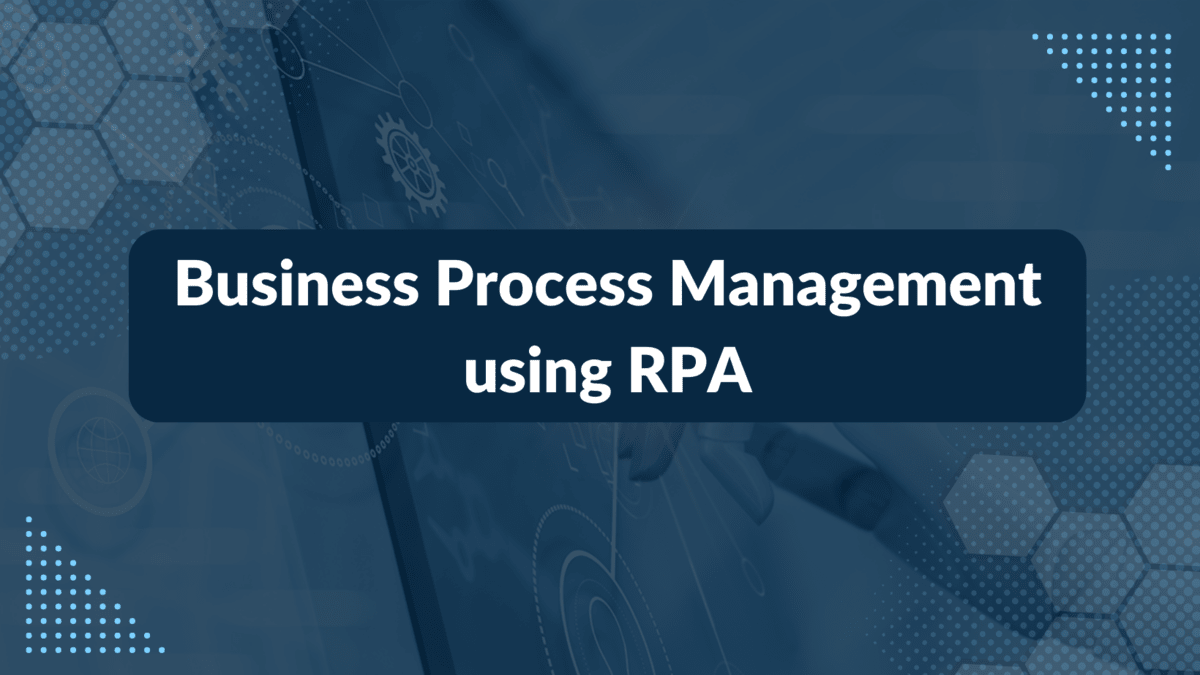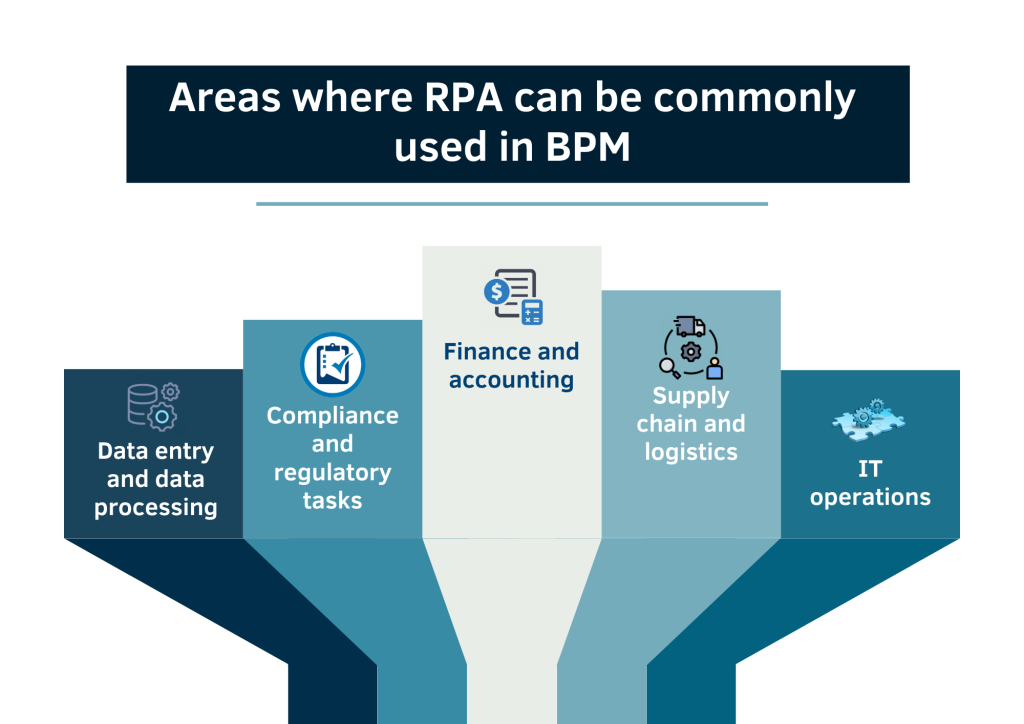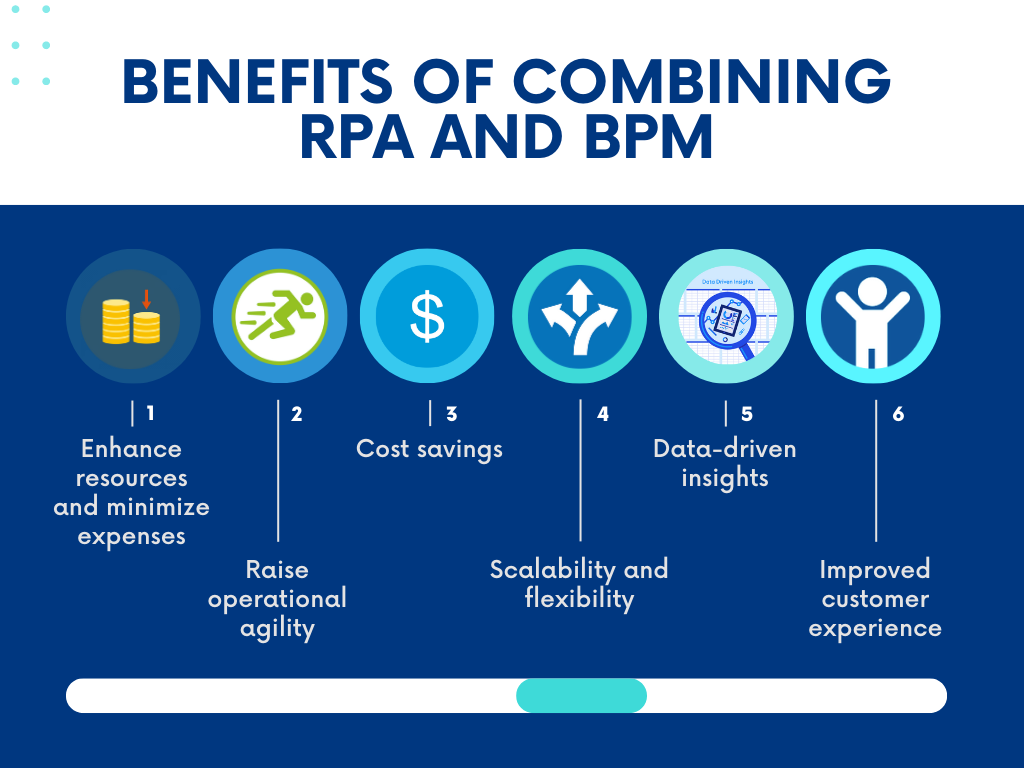
Key takeways
- Business Process Management (BPM) refers to analyzing, optimizing, and automating business processes.
- Implementing BPM is a complex process which requires an interdisciplinary mix.
- RPA and BPM work in tandem to optimize processes to eliminate time-consuming tasks and unify data in a single, convenient place.
- Organizations need to develop a robust framework, define ownership, and establish best practices for managing and scaling RPA initiatives effectively
- Instead, RPA and BPM can complement each other to drive greater efficiency and effectiveness in organizations.
The operations of a business entail numerous tasks and approvals for completion. These tasks pertain to people, IT systems, and various other systems within the organization.
Business Process Management (BPM) refers to analyzing, optimizing, and automating business processes. This kind of management enables businesses to enhance or standardize workflows, deal with unpredictable scenarios, and maintain cost operation’s cost efficiency.
A well-structured business process breaks each task into repeatable steps that workers can follow to achieve the business objectives. These steps enable businesses to optimize resource allocation. They also help identify the impediments and pave the way for process enhancements.
A typical BPM cycle goes through the following stages:
- Analyzing the existing process to identify the areas of improvement.
- Assess how the redesigned process functions in different scenarios.
- Implement enhancements.
- Track the performance of the enhancements.
- Optimize the process on an ongoing basis.
Each of these steps takes several months for execution. A business process requires an interdisciplinary mix for execution.
A BPM process faces challenges such as:
- Lack of clarity of goals.
- Inadequate testing.
- Identifying the right tool.
- Lack of visibility and traceability into processes.
- Hidden processes that are at risk for breakdowns.
Automation technologies that are an integral part of BPM help overcome these challenges and make the process seamless.
In today’s dynamic marketplace, Robotic Process Automation (RPA) is increasingly being adopted by businesses across various industries to automate repetitive tasks and improve operational efficiency.
When applying RPA to BPM, organizations can achieve significant benefits. RPA and BPM work in tandem to optimize processes to eliminate time-consuming tasks and unify data in a single, convenient place.
According to Fortune Business Insights, “The global automation and RPA market is predicted to cross USD 50 billion by 2030, with a high jump of 13.86 billion in 2023, and a CAGR of 20% during the forecast period”. (Source: Fortunebusinessinsights)
RPA offers businesses the benefits of improved efficiency, accuracy, scalability, and cost savings. By automating repetitive tasks, businesses can focus on higher-value activities that require human intervention, creativity, and problem-solving skills. However, it’s important to carefully plan and manage RPA implementations to ensure successful integration with existing systems, proper governance, and ongoing maintenance and support.
Key steps involved in using RPA for business process management:
Identify processes:
Identify the business processes that are suitable for automation using RPA. Look for processes that are repetitive, rule-based, and involve high volumes of data or manual tasks.
Analyze processes:
Analyze the identified processes to understand their current state and identify opportunities for improvement. Consider factors such as process complexity, error rates, cycle time, and resource requirements.
Design automation:
Design the automation solution using RPA tools. Break down the process into smaller tasks that can be automated by software robots. Define rules, logic, and data inputs/outputs for each task.
Develop bots:
Develop the software robots (bots) using RPA software platforms. Configure the bots to perform the defined tasks and integrate them with existing systems and applications, if required.
Test and validate:
Test the bots thoroughly to ensure they perform the tasks accurately and reliably. Validate the automation against defined criteria and use cases to ensure the desired outcomes are achieved.
Deploy and monitor:
Deploy the bots in the production environment and monitor their performance. Continuously monitor and evaluate the automated processes to identify and resolve any issues or bottlenecks.
Continuous improvement:
Continuously improve the automated processes by gathering feedback, analyzing performance metrics, and identifying areas for optimization. Regularly update and enhance the automation to adapt to changing business needs.
By combining BPM with RPA, organizations can streamline their operations, reduce costs, minimize errors, enhance customer experiences, and free up human resources to focus on more value-added tasks.
Here are some areas where RPA can be commonly used in business processes:
Data entry and data processing
The technology can automate data entry tasks by extracting information from various sources, such as emails, and spreadsheets, and then entering it into relevant systems or databases. Furthermore, it can also validate and process data, perform calculations, and generate reports.
Compliance and regulatory tasks
RPA can help organizations ensure compliance with regulations and standards by automating tasks such as data validation, audit trails, and report generation. Bots can retrieve and analyze data, flag anomalies, and generate compliance reports.
Customer service and support
This is a crucial aspect for businesses. Here, RPA can assist businesses with customer service processes by automating tasks like responding to frequently asked questions, updating customer information, and processing routine requests. Also, bots can be used to analyze customer data for personalized service or to route customer inquiries to the right employee.
Customer support, Operations, and IT processes were rated to bring positive impact by BPM efforts combined with RPA. (Source: Fortunebusinessinsights)
Finance and accounting
RPA can streamline financial processes by automating tasks like accounts payable and receivable, invoice processing, expense management, and financial reporting. Bots can extract data from invoices, validate it, and update accounting systems, reducing manual effort and improving accuracy.
Human resources
Common HR processes, such as employee onboarding and offboarding, payroll processing, and leave management, can be easily automated with RPA. Bots can collect and validate employee data, populate HR systems, generate reports, and assist with compliance-related tasks.
Supply chain and logistics
Order processing, inventory management, shipment tracking, and vendor management are some common supply chain and logistics processes. Bots can retrieve and update information from multiple systems, generate shipping labels, and trigger notifications.
IT operations
RPA can automate IT processes, including system monitoring, software deployment, and user access management. Bots can perform routine maintenance tasks, monitor system performance, create trouble tickets, and assist with password resets.
Integrating RPA in businesses comes with certain challenges such as Process standardization, Process complexity, and incompatible systems to interact with various interfaces. Such issues arise if the systems lack APIs, or custom integrations, or are outdated. Organizations need to develop a robust framework, define ownership, and establish best practices for managing and scaling RPA initiatives effectively.

Addressing these challenges requires careful planning, strong collaboration between business and IT teams, and a comprehensive approach to RPA implementation. By considering and proactively addressing these challenges, organizations can successfully integrate RPA and unlock its benefits for improved efficiency and productivity.
Combining RPA and BPM-The Benefits
Combining Robotic Process Automation (RPA) with Business Process Management (BPM) can bring several benefits to organizations.
Here are the key advantages of integrating RPA and BPM:
Enhance resources and minimize expenses
The powerful collaboration of BPM and RPA helps businesses get an in-depth view of their workflows, which as a result reduces the expenses required to execute the processes. The deeper look helps you identify bottlenecks and inefficiencies in processes, enabling organizations to make necessary modifications and remove any obstacles around a specific process.
By integrating RPA and BPM, businesses can achieve greater efficiency, faster cycle times, and improved productivity. This way businesses can work on more important matters which will bring greater efficiency to their business processes.
Raise operational agility
The agile approach makes businesses enhance operational agility and acquire a deep understanding of their workflows. The technology enables you to tailor business processes to customer demands and industry regulations. Organizations can achieve comprehensive process automation, from individual tasks to entire workflows, resulting in increased efficiency and reduced manual effort.
According to Forrester reports, “BPM projects can deliver between 30-50% productivity gains when utilized with automation tools like RPA to manage their tasks. “(Source: Forrester)
Cost savings
Automation through RPA and BPM can lead to significant cost savings. By eliminating manual effort, businesses can reduce costs and reallocate resources to higher-value activities. Additionally, streamlined processes minimize errors and rework, reducing associated costs. Cost savings can be particularly significant in high-volume and repetitive processes.
Scalability and flexibility
RPA and BPM combination enable organizations to scale their automation initiatives efficiently, adapting to changing business requirements and handling increased volumes without significant manual intervention.
Enhanced accuracy and compliance
RPA ensures a high degree of accuracy, reducing errors and exceptions. BPM provides the capability to define and enforce compliance rules, ensuring processes adhere to regulatory requirements. The combination of RPA and BPM improves data quality, reduces compliance risks, and enables organizations to maintain audit trails for better governance.
Data-driven insights
RPA and BPM provide organizations with valuable data and insights into process performance. RPA helps in task completion times, error rates, and exceptions, while BPM offers process analytics and visualization capabilities. By combining RPA and BPM insights, businesses can identify areas for further optimization and make data-driven decisions for continuous improvement.
Improved customer experience
Automating processes using RPA and BPM can result in quicker response times, reduced cycle times, and improved service quality. This, in turn, enhances the overall customer experience.

Conclusion
While Robotic Process Automation (RPA) has significantly transformed the way businesses approach process automation, it is important to note that RPA does not completely replace the need for Business Process Management (BPM) professionals. Instead, RPA and BPM can complement each other to drive greater efficiency and effectiveness in organizations.
The role of humans as BPM professionals is essential in analysis, optimization, governance, and strategic decision-making which can ensure that organizations can fully leverage the benefits of automation while maintaining control and driving continuous improvement.
The integration of RPA and BPM offers a holistic approach to process automation, combining the power of software robots with process analysis and optimization. This synergy brings efficiency gains, cost savings, improved compliance, and better customer experiences, enabling organizations to achieve their business objectives more effectively.
For choosing the best RPA tools for your BPM initiative connect with the professionals at Auxiliobits. We have the expertise to identify the best tools that will boost the efficiency of your enterprise.
Stay tuned for more on Automation!






